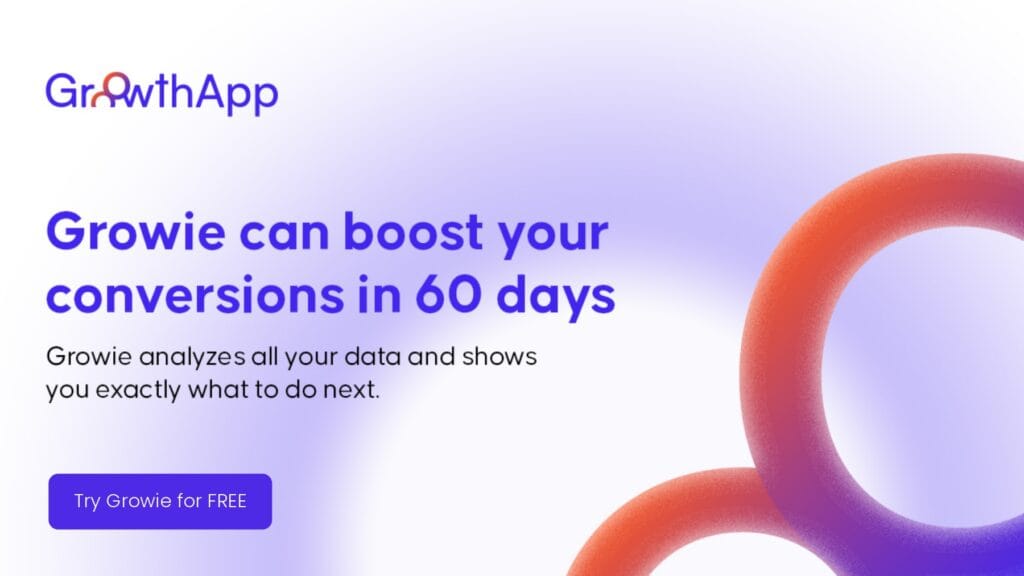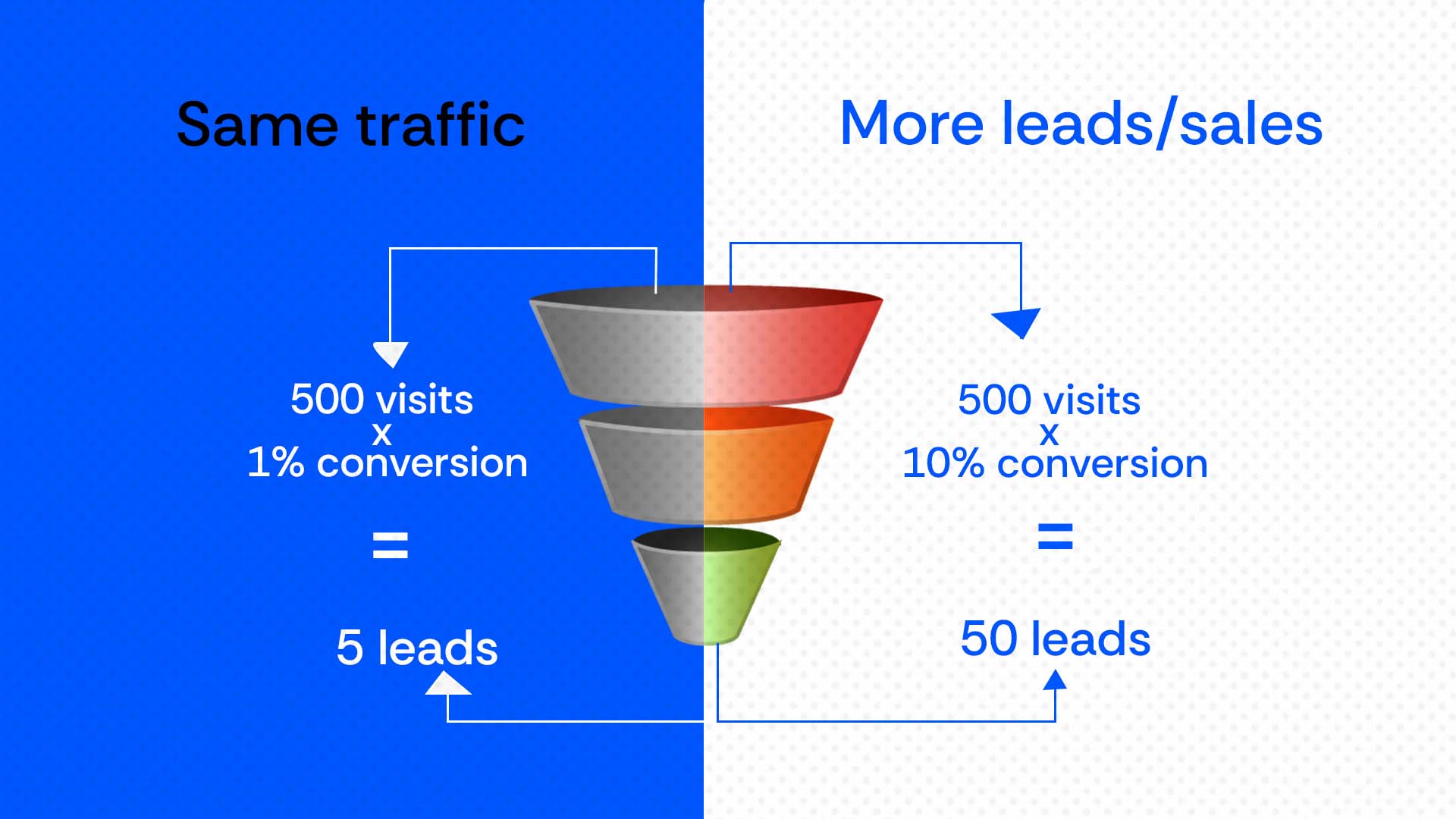Before online tools became the norm, conversion optimization (cro) in marketing was a manual and often labor-intensive process.
Marketers relied on guesswork, customer surveys, and endless trial and error to improve their conversion rates. It involved analyzing customer journeys, tweaking website content based on intuition, and hoping that changes would lead to better results.
The first major breakthrough in CRO came with the development of early analytics tools in the late 1990s and early 2000s. These tools gave marketers their first glimpse into real user behavior—tools like Google Analytics, launched in 2005, offered valuable insights into how visitors interacted with websites.
In 2007, tools like Optimizely and Crazy Egg started providing more specialized features such as A/B testing and heatmaps, allowing marketers to understand precisely which elements of a page were effective and which were not.
Since those early days, the number of CRO tools has exploded. Today, there are hundreds of conversion optimization tools available on the market, ranging from heatmap software and user recording tools to advanced AI-driven platforms that deliver personalized experiences.
Reports show that the CRO software market was valued at USD 10.4 Billion in 2023 and is projected to reach USD 23.64 Billion by 2030, driven by businesses’ increasing need to maximize ROI from their digital assets.
The evolution of CRO tools has made conversion optimization significantly easier and more effective. Businesses now have access to real-time data, automation, and AI-driven insights that allow them to make informed decisions in minutes rather than months.
Research from CXL suggests that companies using CRO tools see an average increase in conversion rates of 20%, a clear indicator of the value these tools bring.
So now, marketers are plagued with the question “which conversion rate optimization tool is best for me/my team?”
That’s where this article comes in—it will guide you through some of the best tools in the market and help you make an informed choice that aligns with your business goals.
What to look for in a CRO tool?
Choosing the right CRO tool is not just about picking the one with the most features or the best price tag; it’s about finding a solution that fits seamlessly into your marketing operations.
To understand what makes a CRO tool effective, it’s helpful to step back and think about how conversion optimization itself has evolved.
In the early days, conversion rate optimization was often synonymous with A/B testing and basic analytics. Marketers would test two versions of a page and see which one performed better. While simple, this process lacked the nuance needed to fully understand user behavior.
Fast forward to today, and CRO has become a holistic discipline that starts from ideal customer profile (ICP) analysis, encompassing every aspect of the website including copy, UI/UX design, and lighthouse performance metrics.
Modern CRO tools not only allow for detailed testing but also optimize every customer touchpoint, leveraging vast amounts of data to predict and personalize user experiences.
This evolution reflects the industry’s understanding that effective conversion optimization involves creating seamless, optimized experiences across all channels and not just tweaking a few elements on a landing page.
So, when evaluating a CRO tool, it’s crucial to consider a few key aspects:
1. How easy it is to use
The usability of a tool is paramount. In the past, marketers would spend hours or even days setting up basic tests, and that inefficiency often hindered experimentation.
Today, a CRO tool must allow users to quickly implement and iterate tests without requiring extensive technical knowledge. If a tool’s complexity outweighs its benefits, it simply won’t get used effectively.
2. Its data integration and analytics capabilities
Conversion optimization is fundamentally about making data-driven decisions. Early tools provided simple data points—like page views or bounce rates—but modern CRO requires deeper insights.
A good CRO tool should integrate smoothly with other analytics platforms, providing a unified view of user behavior across different touchpoints. The ability to consolidate data and derive meaningful, actionable insights from multiple sources is what makes modern CRO so powerful.
3. Can it run A/B tests or provide A/B test strategies?
While A/B testing was the gold standard in the past, the needs of marketers have grown. Today, effective CRO involves not only comparing two variations but understanding the impact of multiple elements simultaneously.
A robust CRO tool should offer various testing methods—multivariate testing, split URL testing, and more—so you can refine each component of your user experience with precision.
4. Personalization is paramount, AI is a plus
As the industry evolved, it became clear that one-size-fits-all approaches were no longer enough. Users expect personalized experiences, and CRO tools must be equipped to deliver this.
Leveraging AI to tailor experiences in real-time has become an essential feature of the best CRO tools, making it possible to serve content that resonates uniquely with each user based on their behavior and preferences.
5. It should be able to scale as your business matures
The CRO landscape is dynamic. A tool that fits your needs today might not be sufficient as your business grows and your requirements evolve. It’s important to choose a tool that can scale with your business, offering more advanced features as your optimization strategy matures.
Similarly, adaptability is key—tools that are updated regularly to incorporate new technologies and industry best practices will be more useful in the long run.
Now, let’s look at 5 CRO tools that fit the bill.
Hotjar is ideal for startup marketing teams
If your marketing team is just at the beginning of its conversion optimization journey or your team needs to gather in-depth behavioral insights, then Hotjar works. Particularly for those who want to understand why users behave a certain way on their website before implementing changes.
The ability to visualize user behavior through features like heatmaps, session recordings, and feedback polls has made Hotjar a popular choice among marketing teams that prioritize usability and customer experience.
Key features
- Heatmaps: Visualize where users click, scroll, and interact with your page. Heatmaps help identify the most engaging parts of your website and areas that might need improvement.
- Session recordings: Replay individual visitor sessions to observe their journey and interactions, allowing you to identify friction points or obstacles that prevent conversions.
- User feedback polls: Collect real-time feedback directly from users to understand their concerns or motivations. This feature is particularly useful for qualitative insights that raw data alone cannot provide.
- Funnel analysis: Track the steps users take before they convert (or drop off), helping you identify which stages in the user journey require optimization.
Pros:
- Provides a straightforward and visual way to understand user behavior.
- Easy to set up and use, making it accessible to marketing teams of all sizes.
- The combination of heatmaps, session recordings, and user feedback provides both quantitative and qualitative insights.
Cons:
- Limited advanced testing capabilities. Hotjar is excellent for understanding user behavior but lacks the more sophisticated A/B or multivariate testing features found in other CRO tools.
- If all you want to do is diagnose problems and haze yourself/ your team about it all day, sure. But if you’re looking for a tool that diagnoses AND tests solutions, then we wouldn’t recommend touching this with a ten foot pole.
Optimizely is ideal for larger marketing teams
If you have gurus and experienced data scientists on your marketing team, then using this CRO tool isn’t a problem for you. Optimizely is a leader in the world of A/B testing and experimentation, providing the tools necessary to optimize the user experience through rigorous testing methodologies.
Unlike tools that primarily focus on diagnosing problems, Optimizely enables marketers to actively test, refine, and validate different versions of their websites to determine which delivers the highest conversion rates.
Key features
- A/B testing: Easily create experiments that compare two or more versions of a webpage to identify the one that drives the most conversions.
- Multivariate testing: Test multiple variables simultaneously to understand how different elements of a page interact and which combinations are most effective.
- Feature flags: Roll out new features to specific segments of your audience and test their impact on user behavior before making them permanent.
- Personalization: Customize user experiences based on demographics, behavior, and preferences, allowing you to deliver targeted messages and offers.
- Statistical analysis: Optimizely includes powerful statistical tools to determine the significance of test results, ensuring that your conclusions are backed by solid data.
Pros:
- Robust and versatile testing capabilities, making it suitable for more advanced CRO needs.
- Excellent integration with other tools, enabling a comprehensive view of user behavior and performance metrics.
- Supports personalization at scale, making it easy to tailor user experiences based on a variety of factors.
Cons:
- Do not suddenly spring this on your marketing team if they don’t have extensive skills and experience with A/B testing and experimentation. Optimizely has a steeper learning curve compared to simpler tools. The depth of features can be overwhelming for smaller teams without dedicated CRO specialists.
- Also has higher cost, which might be prohibitive for startups or small businesses.
VWO is for large marketing teams with dedicated CRO experts
If your marketing team has the resources to experiment extensively and need a platform that supports complex testing and analysis, then VWO is a good choice.
VWO (Visual Website Optimizer) is a well-established Conversion Rate Optimization (CRO) platform that helps marketing teams understand user behavior, test variations, and improve website performance through data-driven experiments.
With a wide range of tools for testing, analyzing, and optimizing user interactions, VWO is designed for deep experimentation and comprehensive reporting. It has solutions for eCommerce, SaaS, eLearning, Media/publication, and enterprise teams.
Key features:
- A/B and multivariate testing: VWO provides an extensive suite of testing capabilities, allowing marketers to run A/B, split URL, and multivariate tests to identify what changes lead to the best performance. This is crucial for refining user experience and determining which elements resonate most effectively with your audience.
- Heatmaps and click maps: VWO offers heatmaps and click maps similar to Hotjar, providing a visual representation of how users interact with your website. This helps in understanding user behavior and identifying potential areas of improvement.
- Behavioral targeting: With VWO, marketers can leverage user behavior data to create personalized experiences for different audience segments. This ensures that each visitor receives content tailored to their interests and needs, ultimately driving more effective engagement.
- Conversion funnels: VWO enables marketers to track the specific steps users take toward conversion, allowing you to pinpoint exactly where users drop off. This level of analysis is invaluable for optimizing each stage of the funnel to maximize conversions.
- Form analytics: VWO provides form analytics that allow marketers to see how users interact with forms on the site. This feature identifies friction points, such as fields that cause users to abandon the form, enabling you to optimize for higher completion rates.
- Push notifications and surveys: VWO also includes tools to engage users directly with personalized messages or to collect feedback through surveys, helping marketers to better understand visitor preferences and continuously improve the website experience.
Pros:
- Comprehensive platform that combines testing, personalization, and behavioral insights, making it suitable for end-to-end conversion optimization.
- Offers both high-level analysis and granular testing options, providing flexibility to address a wide range of CRO needs.
- Scalable solution that can cater to both beginners and advanced users, making it suitable for growing businesses.
Cons:
- The wide range of features can be overwhelming for smaller teams without dedicated CRO specialists.
- Pricing can be high for startups or smaller businesses, making it less accessible for those with limited budgets.
UserTesting is ideal for marketing teams that need deep qualitative insights into user behavior
UserTesting is a platform that focuses on providing real user feedback to help marketers understand the motivations and behaviors of their website visitors. It offers a direct window into the thoughts of real users as they interact with your website, allowing you to uncover pain points and opportunities for improvement.
Key features:
- Live video recordings: UserTesting provides video recordings of real users navigating your website while sharing their thoughts aloud. This feature gives marketers deep insights into user experiences, revealing usability issues that might not be apparent through traditional analytics.
- Written feedback and surveys: Alongside video feedback, UserTesting allows you to collect written responses from participants, which can help to clarify specific issues or gather more detailed qualitative data.
- Customizable tests: Marketers can create customized tasks for users to complete, allowing them to focus on specific aspects of their website or user journey. This level of customization makes it possible to target particular problem areas with precision.
- Audience targeting: UserTesting allows you to specify demographic and behavioral criteria when selecting participants, ensuring that the feedback you receive is relevant to your target audience. This helps in tailoring your optimization efforts to the needs and preferences of your core users.
Pros:
- Provides real, unfiltered feedback from actual users, which can be more insightful than quantitative data alone.
- Easy to set up and initiate tests, making it accessible to marketing teams with varying levels of CRO expertise.
- Helps uncover usability issues and user frustrations that traditional metrics may not capture.
Cons:
- UserTesting focuses on user feedback rather than experimentation, which means it lacks testing capabilities like A/B or multivariate testing.
- The cost of running frequent tests can add up, especially if you require feedback from a large number of participants or need to conduct tests regularly.
GrowthApp is for every marketing team, regardless of size and level of CRO expertise
GrowthApp AI is perfect for all marketing teams, especially startups, small-to-medium marketing teams, or businesses looking for an easy way to get started with CRO. It’s an AI CRO tool designed for teams with limited conversion experience or those who want to run conversion optimization without hiring experts.
GrowthApp AI provides a guided, user-friendly approach to CRO, allowing any team—regardless of expertise—to confidently improve their conversions. With its AI-powered virtual assistant, GrowthApp AI not only helps teams analyze data but also provides actionable strategies to address friction points, ensuring every aspect of the customer journey is optimized.
The tool’s focus on simplicity, guidance, and ease of use makes it ideal for marketing teams that want to improve conversions without needing a CRO expert.
Key features:
- AI-driven analysis: GrowthApp uses machine learning to analyze user data, identify pain points, and predict which changes are likely to yield the highest improvement in conversion rates.
- Integrated strategy recommendations: Beyond identifying issues, GrowthApp provides tailored strategic suggestions to optimize both websites and broader customer journeys, offering a plan for how to implement changes effectively.
- UI/UX analysis: Clear analysis of user experience elements to identify pain points and friction.
- Business offering insights: Guidance on optimizing product offerings and messaging for better customer engagement.
- Full customer journey optimization: Analysis and recommendations for all customer touchpoints, from website to messaging.
- Behavioral segmentation: Segment users based on their behavior, preferences, and interactions to understand different audience segments and target them effectively.
- Performance tracking: With AI-driven Insights, the tool is designed with generated insights revealing trends and patterns enabling users with the opportunity to drive growth and optimization
- Integration with Google Analytics and third-party tools: GrowthApp uncovers patterns humans might overlook, identifying friction points and drop-offs in the user journey while predicting user behavior for deeper personalization. By aggregating data from multiple sources, it reveals new optimization opportunities, offering a comprehensive view for better decision-making
Pros:
- GrowthApp AI’s virtual assistant provides step-by-step guidance and concrete next steps, making CRO accessible even to those without much prior experience.
- The platform is intuitive and easy to set up, allowing teams to start improving conversions quickly.
- GrowthApp AI helps teams optimize beyond just their website—focusing on the entire customer journey, including offerings, messaging, and performance metrics.
- As a new tool, there might be limited tools and features, but you can submit requests for new features and tools you use in your marketing team, and it will be developed/integrated.
- GrowthApp’s AI pinpoints key audience segments and delivers personalized recommendations, helping marketers tailor content that resonates with specific groups. This boosts conversion rates, builds trust, and fosters long-term loyalty.
Cons:
- GrowthApp AI is newer on the market, so it lacks the depth of case studies and user feedback that more established tools like VWO have.
Bottom line? CRO is achievable with any of these tools
Conversion Rate Optimization has come a long way from the manual, intuition-driven processes of the past. With the right tools, marketers can now harness powerful data insights, advanced testing capabilities, and AI-driven strategies to drive meaningful improvements in their user experience and conversion rates.
While you’re ruminating on which to choose, remember GrowthApp is cheaper, accurate, more empowering, adaptable to all teams, and scalable with fast action CRO strategies from your AI CRO expert.



